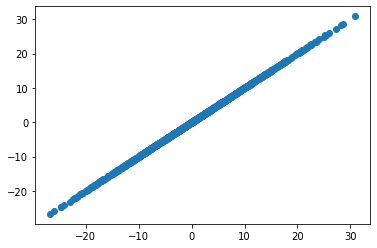I want to discuss why you observed all the data on the particular line that you did.
$\newcommand{\1}{\mathbf 1}$If you have a random variable $X \sim \mathcal N(\mathbf 0, \Sigma)$ where $\Sigma$ has all the same element, then $\Sigma \propto \1\1^T$ so you have a rank $1$ covariance matrix.
I'll consider the more general problem of what it means to have a multivariate Gaussian with a low-rank covariance matrix. Suppose $X \sim\mathcal N_p(\mathbf 0, \Sigma)$ and $1 \leq \text{rank}(\Sigma) := r < p$. We can factor $\Sigma$ as
$$
\Sigma = \tilde Q\tilde \Lambda \tilde Q^T
$$
via the spectral theorem with $\Lambda = \text{diag}(\lambda_1,\dots,\lambda_r, 0, \dots, 0)$.
This means that $\Sigma$ can actually be represented as
$$
\Sigma = Q\Lambda Q^T
$$
where $Q$ is the first $r$ columns of $\tilde Q$ and $\Lambda = \text{diag}(\lambda_1,\dots,\lambda_r)$ contains the non-zero eigenvalues.
Let $Z \sim \mathcal N_r(\mathbf 0, I)$ and define
$$
Y = Q\Lambda^{1/2}Z.
$$
$Y$ is a linear transformation of a Gaussian so it too is Gaussian, and
$$
\text{E}(Y) = \mathbf 0 \\
\text{Var}(Y) = Q\Lambda^{1/2}\Lambda^{1/2}Q^T = \Sigma
$$
so $Y \sim \mathcal N(\mathbf 0, \Sigma) \stackrel{\text d}= X$.
This shows that we can think of $X$ as being generated by a low dimensional Gaussian that we map up into our high dimensional space, and this explains why there is still randomness but not over all of $\mathbb R^p$. In particular, $X$ is constrained to the $r$-dimensional column space of $Q$.
In your case we have $\Sigma \propto \1\1^T$ which means that $r=1$ and $Q = p^{-1/2}\mathbf 1$. This shows that $X \in \text{span}(\1)$ which is what you observed.
One final comment: these Gaussians with low-rank covariance matrices do not have pdfs in the usual sense because $P(X \in \text{ColSpace}(Q)) = 1$ yet the Lebesgue measure of $\text{ColSpace}(Q)$ is zero w.r.t. the Lebesgue measure on $\mathbb R^p$. This is one advantage to defining a multivariate Gaussian as a random variable where every linear combination is Gaussian since then there's no issue with zero determinant covariance matrices in the expression for the usual pdf.

